We independently evaluate all recommended products and services. Any products or services put forward appear in no particular order. If you click on links we provide, we may receive compensation.

Key Specs: Spyderco Swayback
Blade
As with the other knives Mr. Slysz has teamed up with Spyderco on, the Swayback brings the mirrored stonewash finish to this wharncliffe bladed knife. With 3.5” of CTS-XHP steel, and a blade stock thickness of .14”, this is not the delicate traditional blade you’d find on grandpa’s leather belt sheath. This is a robust, stout blade, albeit with a delicate tip. The hollow grind allows for a nice, thin edge, while maintaining a thick spine for a more confidence inspiring EDC choice. The show side of the blade boasts the classic Spyderco logo, as well as the steel composition and “Spyderco” name, and keeps the text very small for a touch of class. The lock side of the blade has “Taichung Taiwan” at the heel of the blade, as well as the Slysz logo next to the Spydie hole. To keep with the “Bond, James Bond” level of class, while adding functionality simultaneously, the blade has a nice swedge ground into the spine of the blade nearing the tip, making for a great puncturing tip for initiating cuts in your hard-to-open packages.
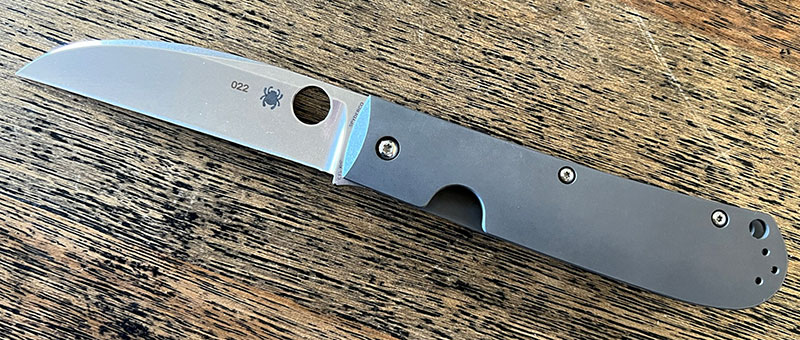
Deployment / Lockup
A titanium frame lock folder is typically a knife that’s easy to open and close with one hand, while keeping a very strong lockup. But, as with other Slysz designed Spyderco knives, the opening hole leaves something to be desired. That is, more space. The hole itself is significantly smaller than with knives like a Paramilitary 2 or Shaman, but that’s only half the battle. The other issue with deployment on the Swayback is the lack of access to the opening hole and lock bar access portion of the handle. There is an aesthetic aspect to this choice in design, that is, to keep the blade from being overly tall, and subsequently making the look of the knife too utilitarian. It definitely keeps a classy look in this regard, but at the cost of a hard-to-reach opening hole. And, to make matters worse, makes the lock side of the blade basically impossible to reach the opening hole. So, as a potentially ambidextrous occasion, the Swayback is limited to almost exclusively right handed users. Maybe this is debatable with a frame lock in the right-handed orientation as is, but it’s a bit frustrating to not have access to one handed deployment on either side of the knife.
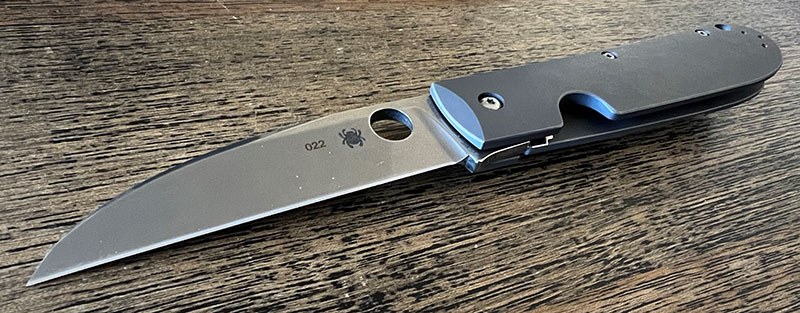
The smooth nature in which the Swayback glides the blade from closed to locked open is just as you’d expect from a stonewashed blade riding on phosphor bronze washers. And the lockup is nice and tight, too. It’s quite the pleasurable feeling to have a blade that is so sleek and smooth, paired with a lockup that’s so tight and rigid. There’s the constant push for folders in today’s era to be “fall shut”, and insanely smooth, but that’s not all it’s cracked up to be in my opinion. Knives on bearings aren’t inherently a bad thing, but I prefer the deliberate opening of a folder with washers. Bearings, in my experience, are quite a bit more finicky in reliability and smoothness with pocket lint and ambient dirt and debris involved. So, as the Swayback makes it’s way into the pocket, it’s nice to know that it’s deployment will likely never be hindered by a light dose of EDC pocket lint.

Features, Fit and Finish
The Spyderco Swayback maintains a sleek, unassuming overall look. But somehow packs in a ton of features that may not be immediately obvious to the untrained eye. Namely, the titanium scales. Not only are they made of possibly the best knife handle material for strength, longevity, and corrosion resistance, but they are stonewashed and rounded over their broad sides. Although that may not sound overly interesting, it’s not found very often in today’s world of titanium frame lock knives. Even the infamous Chris Reeve Knives handle scales are completely flat along the face of the handles on all their folders. It’s a slightly unusual trait for all metal handle scales these days, but does keep with the design language of the Slysz Bowie (now discontinued, although there was a recent sprint run as well).
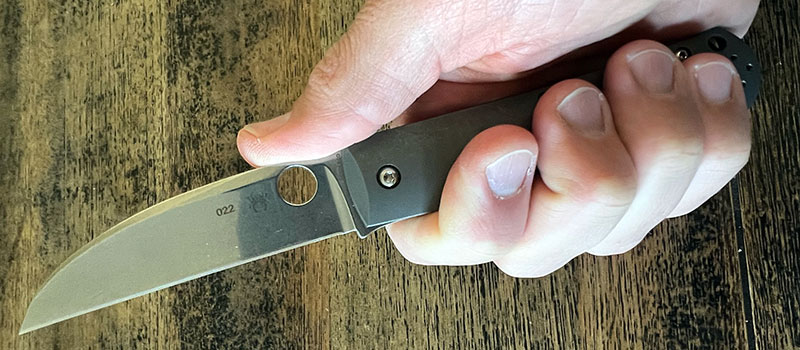
Along with the sculpting of the scales, there is internal milling found inside the handle as well. But not just the run-of-the-mill weight reduction milling. It’s found where the steel lock bar insert is installed (which cleverly doubles as a lock bar overtravel stop, internally), as well as the internal stop pin races. The stop pins (yes, plural) are installed on the blade by means of torx screws on the blade itself, and the pockets for them to ride on (and stop on for lockup) are milled into the inside of the handle scales. Lack of a pivot bushing isn’t hurting my feelings on this knife, as it seems to have no bearing on action in any negative manner. Moving down the scales are two standoffs to keep the scales in place, with plenty of rigidity added along to the already strong titanium scales.
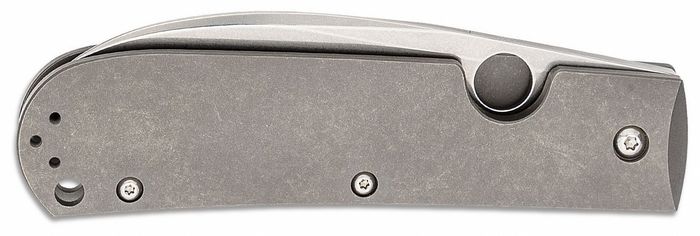
There can be a lot of negativities found in forums and overall mindset of consumers to buy domestically produced products. I do agree with putting effort into purchasing domestically, but Spyderco’s Taichung plant sure makes a well finished product. Yes, Spyderco’s knives from any of their main plants (Golden, Colorado, or Seki City, Japan, for example) are made with great fit and finish. But the Taichung plant is well known for its ability to go above and beyond in this department. Every bit of the knife, scales and blade, is chamfered, polished, and smooth. The opening hole is comfortable to use (albeit with limited access), scales are smoothed yet provide decent grip, screws all sit just below flush, and all the bells and whistles are packed under the hood for the understated look that the Swayback has.
Field Test
Using the Swayback is, in short, great. Of course, the wharncliffe blade shape has limitations built into the design on any knife, like tabletop use. Cutting up some fruits on a cutting board is doable, but not preferable. The blade having a narrow profile, thick stock, and straight edge, all make it difficult to use in this way. I also use 3/8” sisal rope on my wood workbench for a test of ergonomics and blade sharpness, in which case the Swayback is again not well suited for. The ergos aren’t bad in this regard, just okay at best. And the handle shape feels backwards (which is probably obvious just by a quick observation of the knife), and doesn’t have any semblance of an index finger groove. Again, not bad, just not preferable for harder cuts as your hand may slide up onto the blade.
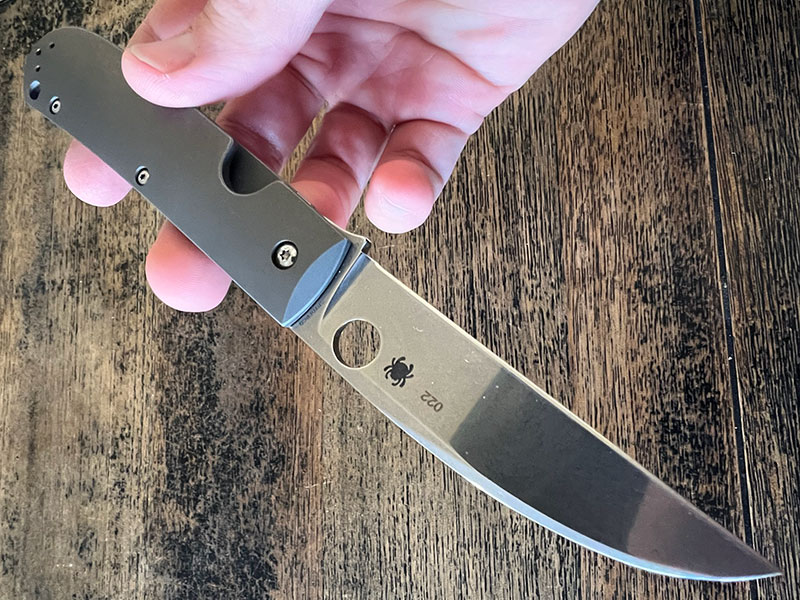
The Swayback is typically a slip joint folding knife, without a lock, and in a smaller overall size than Spyderco’s variant. Having extra hand room on the handle isn’t particularly a bad thing, but the knife overall feels long for it’s style. It’s like a 4 door oversized Mini Cooper. I truly believe Spyderco and Mr. Slysz should have gone closer to the 3” blade sized knife for this production knife. And moving into cardboard cutting, the 3.5” blade does come in handy, but would suffice with about ½” less cutting edge without an issue. But I digress, the Swayback, again with it’s hollow grind and (in my opinion) underrated steel composition, glides through cardboard boxes with ease. You’ll probably be just as satisfied as me when pushing the blade through a long section of cardboard and hearing the “zip” sound it makes throughout the cut. Edge retention, even on the factory edge, was great. I gave it a little strop after a sizeable amount of use, and it was still shaving sharp.

Carrying the Swayback is decent, but again, could have a couple improvements. Namely, the pocket clip. Sure, it’ll keep the knife in the pocket most the time, but there’s a strange design choice with the clip itself. It’s raised up a lot higher than almost all other Spyderco knife clips. The spoon shape of the clip end finds it’s way over the pocket seam without issue, but the raised portion of the clip sits up and away from the handle way too far. Pairing this oddity with the smooth handle scales makes for a potentially dangerous scenario where the clip could easily snag on something when carrying the knife, and have it either raised up unintentionally from the pocket, or worse, removed and thrown to the floor completely. Spyderco did a great job with another titanium frame lock in the weight department, though. 3.9 ounces is by no means a lightweight knife, but for a 3.5” blade and Ti scales, coming in sub 4 ounces is a great attribute.
Alternatives
All these knives available at BladeHQ.
Should we do it? Should we, once again, make the argument that the Sebenza is a comparable alternative to the Swayback? Sure, why not… With Chris Reeve Knives recently having a price increase, their base models in the large size configurations are now $500. And comparing the Swayback at $315, there is a lot to be said in favor of the Swayback when compared to CRK’s insingo bladed models. CRK has gone to a new blade steel, S45VN, and is already on the way to making most of their folders in CPM-Magnacut blade steel. But I’d argue that CTS-XHP blade steel, as found on the Swayback, is very close in edge retention, toughness, and corrosion resistance when compared to CRK’s steel offerings. Yes, the CRK folders are renowned for their insane tolerances and near perfection in all production categories, but the Swayback absolutely gives any Sebenza 31 a run for it’s money.

Admitting personal preference, I’d opt for the Spydiechef over the Swayback, all things considered. The ‘Chef is such a unique looking knife, uses LC200N blade steel (which is nearly completely rust proof), similar stonewashed titanium handle scales, and made with a frame lock as well. It’s slightly smaller than the Swayback, with a 3.3” blade, and 3.8 ounces. So, all things compared, a similar knife in size, materials, and level of unique style. But, it’s $45 cheaper, has a much thinner overall profile, and, again, I think it just looks cooler.

Benchmade has been making their flagship 940 Osborne model for decades. And, it’s still a relevant knife it today’s market, even with all the innovation we’re seeing on a regular basis from all manufacturers. The 940 base model has aluminum handle scales, an Axis lock, S30V blade steel, and a very similar overall size to the Swayback (3.4” blade, but only 2.9 ounces). The sheepsfoot blade has a similar overall style to the Swayback, but arguably a much more functional shape with a thicker tip, and some belly near the tip of the blade. And, it was available with titanium scales for a short time, but can be modified easily with aftermarket parts if desired, which would inevitably drive the price up to nearly what the Swayback retails for. All things said, it’s a good alternative to the Swayback in many ways.

Conclusion
The Spyderco Swayback is a well made knife in all aspects. With a comfortable handle, great fit and finish, and great blade steel, it’s another offering in a continuing partnership with Marcin Slysz and Spyderco. There are many other knives from Spyderco, as well as other manufacturers, that have similar attributes, pricing, and materials. But there are very few swayback designed knives, especially in locking-folder form. I would’ve liked to see the Swayback ½” smaller in blade and handle, and have a modification to the handle to allow a bigger access to the small opening hole and lock bar access. But, all things considered, it’s a great knife for the price, and will be a great choice for anyone looking to purchase a unique, usable high-end knife with an old school styling mixed with modern technology and materials.
- High level of production, quality materials, modern style mixed with traditional
- Slightly high price, difficult to deploy and unlock, larger than necessary for it’s style
Spyderco Swayback
Quality/Performance - 83%
Value for Money - 75%
79%
The Spyderco Swayback is a great knife for the price, and a good choice for anyone looking for a unique high-end knife with old school styling mixed with modern tech.





